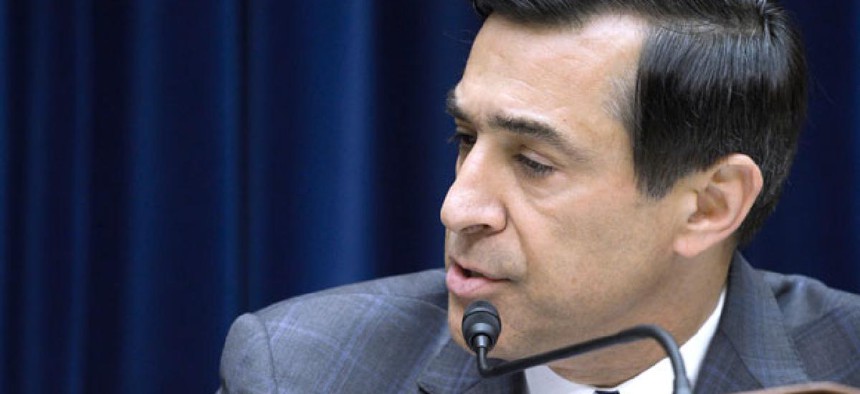Inspectors General Dragged Into Sequestration Debate
House panel explores agency compliance with savings recommendations.
Two agency deputies and their inspectors general on Tuesday were pulled into Congress’ politicized debate over finding alternatives to the automatic spending cuts now unfolding under sequestration.
House Oversight and Government Reform Committee Chairman Darrell Issa, R-Calif., called the hearing to counter what he dismissed as mere “stories” from the Obama administration about the dire effects of the sequester, mocking recently reported “tales of massive teacher layoffs, pay cuts for Capitol janitors and security guards and other cuts that seem to defy common sense.”
In launching what will be a series of hearings, Issa said he hoped to find “real savings” of as much as $67 billion in the open and unimplemented recommendations from inspectors general, which have grown, he said, from 10,894 in 2009 to 16,906 today.
The result was a routine review of the ongoing oversight agendas by inspectors general from the Transportation and Education departments, coupled with new agency warnings about harm from sequestration and continuing disputes among lawmakers.
“The irony is that we are holding a hearing today on IG recommendations to make these two agencies more effective and efficient, but it will be more difficult for these agencies to implement these recommendations while their budgets are being cut and their employees are being furloughed,” said ranking committee member Rep. Elijah Cummings, D-Md. “Even IG offices themselves will feel the negative effects of sequestration, hindering their ability to conduct the very oversight work we are praising them for today.”
Rep. Jim Jordan, R-Ohio, blasted Education Secretary Arne Duncan’s recent warnings about teacher layoffs and criticized the two agency leaders for not having spent more of the past 19 months planning for sequestration and preparing answers on such topics as agency efforts to curb spending on conferences. “It seems to me instead of having the secretary scaring people, that you would cut back on conferences,” Jordan told Deputy Education Secretary Anthony Miller.
Agency officials had Rep. Gerry Connolly, D-Va., at their defense. He rephrased Republicans’ questions on spending on training conferences by sarcastically asking Deputy Transportation Secretary John Porcari, “What kind of training? How to party?”
Porcari explained that the Federal Aviation Administration’s biggest gathering, though “technically a conference, really has a safety agenda, to update and educate employees on safety. We’re trying to build a safety culture,” he said. “It’s a vital part of what we do.”
As for planning for sequestration, the Education Department has been getting ready “in varying degrees, since the beginning of the year,” said Miller, “But both parties thought it was not going to take effect.”
Miller said his department had done “a good job” in complying with a presidential executive order to reduce spending on travel, printing and supplies by 20 percent. He called the sequester counterproductive, saying it required a “Sophie’s choice” of deciding among cuts in Title I, special education, and programs for Native American students. He conceded the department could move quicker in some areas: “We agree with the inspectors general that we can resolve our audits in a more timely way,” he said.
Education Inspector General Kathleen Tighe reported that her own staff will suffer a $3 million cut under sequestration, prompting furloughs of 10 to 11 days for all staff, including herself, as well as cuts in IT security contracts and support for risk modeling.
She reviewed her auditing team’s work on such areas as the department’s management of defaulted student loans and improperly issued Pell Grants. “Our work is effective only if the department implements timely corrective actions to address identified deficiencies or weaknesses that hamper its ability to carry out its mission,” she said.
Transportation IG Calvin L. Scovel III offered a similar review of agency responsiveness to his team’s audits in such areas as managing infrastructure spending and gathering safety data.
“Some recommendations, however, remain open for an extended period for various reasons, such as the complexity and magnitude of the recommendation and the number of actions required to implement the recommendation,” he said. “In some cases, recommendations remain open because the department or agency does not concur with our recommended actions. In these cases, we work with the department or agency to seek alternative actions that meet the intent of our recommendation.”
Porcari testified that Transportation “has established sound systems for interacting with the OIG that have enabled us to close 505 audit recommendations during calendar 2012, with over $1 billion in program funds either recovered, reprogrammed, offset, or put to a better use. This represents a 19 percent increase in recommendations closed compared to the previous year, and 58 percent more recommendations than DOT closed in 2009,” he said.
Issa pressed him to identify savings and efficiencies given the current budget crunch, saying the number of airline flights and air traffic controllers are both down.
Porcari said under sequestration, 74 percent of his department is exempt, which means the cuts fall “disproportionately on the FAA, so 5 percent is like 9 percent. “The vast majority of our 47,000 employees will be significantly impacted,” he said. “We’re in process of notifying them now of furloughs of up to 11 days, one per two-week pay period.”
His agency’s warnings about possible flight delays due to furloughs are real, he said, and are based on analysis of data from bad weather days at hub city airports such as O’Hare in Chicago, where one of the two towers could be shut down.




